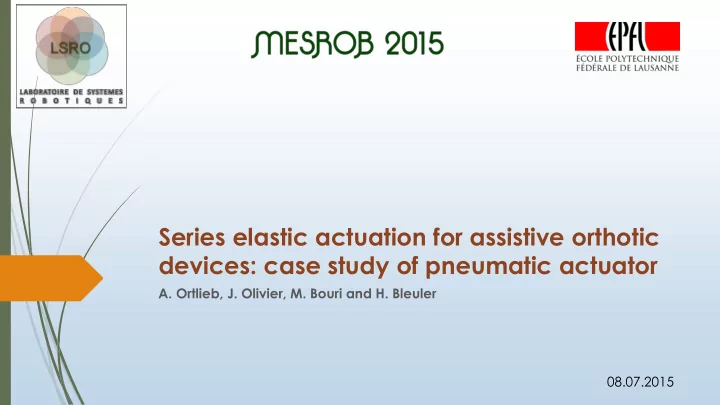

Series elastic actuation for assistive orthotic devices: case study of pneumatic actuator A. Ortlieb, J. Olivier, M. Bouri and H. Bleuler 08.07.2015
Context: walking assistive devices 2 Stroke patients Elderly Stabilize upper How body Paraplegics Who Assist/mobilize/correct Neuro-muscular lower body motions disorders Safety (prevent falls) Autonomy Why (through mobility) Health (provide (natural) motion)
SEA : series elastic actuator 3 1997 MIT patent (G. Pratt, M. Williamson): Elastic actuator for precise force control Spring Motor Reduction Position Force UT-SEA actuator 2012 GM patent: Rotary SEA RoboKnee from Yobotics inc LOPES, Twente university A Novel Compact Torsional Spring for Series Elastic Actuators for Assistive Wearable Robots, Carpino et al. 2012
SEA advantages 4 Actuators properties regarding walking activity of the ankle joint Precise force control Bio-inspired (muscle-tendon) Adapted to locomotion Reduction in peak power, energy required, force User friendly (compliant) A Comparison of Parallel- and Series Elastic Elements in an actuator for Mimicking Human Ankle Joint in Walking and Running, Grimmer et al. 2012
Goal and motivations 5 Evaluation of pneumatic cylinders as candidate to SEA for assistive orthotic devices Chamber 1 Chamber 2 Compressible gas Force ∆𝒚 Motivations Compressed gas Dilated gas Displacement Pneumatic cylinders are compact double-SEA Elastic behavior is “imposed” : P V = n R T
Pressure Material sensors 5/3 Distributor 6 Double acting Sink 1 [bar] pneumatic cylinder Bore Ø50mm Source 4 [bar] 400 mm height Sink 1 [bar] Proportionnal electrovalves Frame Output lever Sensors 1x Encoder for output angle • 2x pressure sensors for output force • Axis for Properties encoder 120 ° Max torque: 50-60 Nm [@ 4bar] • Weight: 2.4 kg • 120 mm 100 mm width
at rest loaded P1’, V1’ P1, V1 Experiment 7 𝒚 𝟏 ∆𝒚 Factors Pressure at rest P 0 [1 to to 4 bar bar] P2’, V2’ P2, V2 Position at rest α 0 [1/4 to to 3/4 of of cylin cylinder len ength] ∆𝜷 Torque output Γ M [0 to to 20 Nm] 𝜷 𝟏 𝚫 𝑵 Response M Displacement Δα Design of experiment m m P b out 0 mn 0 Parametric model m 2 n 2 Box-Behnken design Forward selection and backward elimination 𝑄 0 (optimization of final model) 𝛽 0 Γ 𝑁
Results 8 Backward elimination Forward selection R 2 = 0.988 R 2 = 0.998 2 2 2 3 cst b P b P b P cst b P b P b P out 11 0 0 02 0 21 0 out 01 0 02 0 03 0 0 𝑄 0 = 3 bar 𝑄 0 = 4 bar 𝑄 0 = 2 bar 𝑄 0 = 1 bar 𝑝𝑣𝑢 (Nm) Γ
Application to human locomotion (1) 9 Walking curves from measurement of D. Winter, 1984 HIP KNEE ANKLE 160 80 50 Torque (Nm) plantar flexion dorsiflexion extension extension flexion flexion 20 60 5 20 20 20 15 10 60 0 Swing phase Angular position (deg) Stance phase
Application to human locomotion (2) 10 Walking curves from measurement of S. Ounpuu, 1994 HIP KNEE ANKLE 130 60 50 Torque (Nm) plantar flexion dorsiflexion extension extension flexion flexion 40 80 30 20 20 0 30 0 70 Swing phase Angular position (deg) Stance phase
11 Application to human locomotion (3) Stiffness [Nm/deg] 0 1 2 3 4 5 6 7 Joints vs pneumatic SEA stiffness P=1 bar P=2 bar P=3 bar P=4 bar P=5 bar W. Stance 1 O. Stance 1 Hip O. Stance 2 W. Swing O. Swing W. Stance 1 O. Stance 1 Knee W. Stance 2 W. Swing O. Swing W. Stance 1 O. Stance 1 Ankle W. Swing O. Swing
Conclusions 12 Pneumatic cylinders are (pros) Able to reproduce human joints behavior (during walking) Simple double-SEA Can be downsized using higher pressure Different mode (active, damping, passive) Pneumatic cylinders have/are (cons) Bulky/heavy power source (tank or pump+battery) Noisy due to air flow Dry friction (rod)
Further study 13 Evaluation of impedance control with pneumatic actuator Application to locomotion and evaluation
Series elastic actuation for assistive orthotic devices: case study of pneumatic actuator A. Ortlieb, J. Olivier, M. Bouri and H. Bleuler Questions ?
Recommend
More recommend